The global avian influenza antigen testing market is valued at USD 176.5 million in 2025 and is projected to reach USD 1,894.6 million by 2035, recording an absolute increase of USD 122.1 million at a CAGR of 5.4%. This progression expands the industry 1.7 times compared with the baseline, but innovation trends are expected to determine how effectively market participants capture growth. The trajectory highlights shifts from traditional diagnostic kits to advanced rapid testing formats, automated systems, and field-ready devices during the horizon ending 2035.
One of the most significant innovation trends is the move toward rapid, point-of-care antigen testing systems. Traditional laboratory-based diagnostics, while accurate, face limitations in outbreak situations where time-sensitive detection is critical. Portable antigen test kits, equipped with lateral flow assay technology, are becoming widely adopted in poultry farms and veterinary clinics. These kits reduce turnaround times from days to minutes, making them essential for early containment strategies in the years ending 2030. Advances in biosensor technology also support improved sensitivity and field usability, reinforcing rapid response protocols.
Automation and integration with digital platforms represent another critical innovation pathway. Automated immunoassay analyzers designed for veterinary labs provide higher throughput, reducing human error and enhancing consistency. Cloud-enabled data collection platforms that connect directly with testing devices are gaining traction, enabling real-time disease surveillance across poultry-producing regions. By the year 2035, integrated surveillance ecosystems linking farms, diagnostic labs, and regulatory bodies will reshape monitoring frameworks. These innovations not only streamline disease detection but also build transparency for global poultry trade networks.
Multi-pathogen detection capability is also emerging as an important trend. Innovation in multiplex testing platforms allows simultaneous detection of avian influenza along with other viral or bacterial pathogens that affect poultry health. This reduces costs, minimizes testing time, and increases efficiency, making it attractive for commercial poultry operators managing large flocks. Multiplex solutions are expected to transition from research use to broader commercial deployment as validation standards are met during the later stages of the forecast period ending 2035.
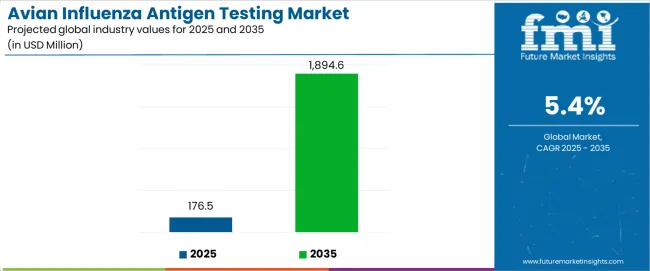
Between 2025 and 2030, the avian influenza antigen testing market is projected to expand from USD 176.5 million to USD 234.9 million, resulting in a value increase of USD 58.4 million, which represents 47.8% of the total forecast growth for the decade. This phase of development will be shaped by rising demand for point-of-care diagnostic solutions and enhanced surveillance protocols, product innovation in rapid detection technologies and molecular testing platforms, as well as expanding integration with poultry production systems and veterinary diagnostic networks. Companies are establishing competitive positions through investment in specialized testing capabilities, field-deployable diagnostic systems, and strategic market expansion across poultry farming, commercial production, and governmental surveillance applications.
From 2030 to 2035, the avian influenza antigen testing market is forecast to grow from USD 234.9 million to USD 298.6 million, adding another USD 63.7 million, which constitutes 52.2% of the ten-year expansion. This period is expected to be characterized by the expansion of specialized veterinary applications, including advanced multiplex testing systems and next-generation antigen detection solutions tailored for specific outbreak scenarios, strategic collaborations between diagnostic manufacturers and agricultural organizations, and an enhanced focus on regulatory compliance and quality assurance standards. The growing emphasis on disease prevention and biosecurity management will drive demand for comprehensive avian influenza testing solutions across diverse agricultural applications.
| Metric | Value |
|---|---|
| Estimated Value in (2025E) | USD 176.5 million |
| Forecast Value in (2035F) | USD 1,894.6 million |
| Forecast CAGR (2025 to 2035) | 5.4% |
The avian influenza antigen testing market grows by enabling poultry producers and agricultural organizations to optimize disease management while accessing specialized diagnostic technologies without substantial in-house laboratory investment. Poultry companies and agricultural producers face mounting pressure to implement comprehensive biosecurity protocols and rapid disease detection while managing complex surveillance requirements, with specialized antigen testing services typically providing 50-70% faster detection completion compared to laboratory alternatives, making rapid testing essential for effective outbreak management. The poultry industry's need for regulatory compliance and application-specific diagnostic capabilities creates demand for comprehensive testing solutions that can provide superior accuracy, maintain consistent quality standards, and ensure reliable operation without compromising disease control efficacy or production continuity timelines.
Government initiatives promoting animal health surveillance and disease prevention drive adoption in poultry production, agricultural operations, and veterinary applications, where diagnostic accuracy has a direct impact on outbreak prevention and flock health management. System complexity constraints during large-scale surveillance programs and the technical requirements for field-based testing may limit accessibility among smaller farming operations and developing regions with limited infrastructure for sophisticated diagnostic systems.
The avian influenza antigen testing market is segmented by test modality, sample type, end user, and region. By test modality, the avian influenza antigen testing market is segmented into rapid antigen test kits, ELISA, immunofluorescence, and other methods. Based on sample type, the avian influenza antigen testing market is categorized into swabs, tissue, fecal, and others. By end user, the avian influenza antigen testing market includes veterinary diagnostic labs, poultry farms, government/surveillance agencies, and research institutes. Regionally, the market is divided into Asia Pacific, Europe, North America, and other key regions.
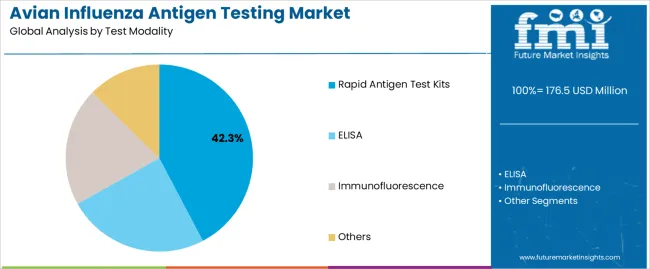
The rapid antigen test kits segment represents the dominant force in the avian influenza antigen testing market, capturing approximately 42.3% of total market share in 2025. This established testing category encompasses solutions featuring sophisticated point-of-care detection and field-deployable diagnostic capabilities, including advanced chromatographic methods and specialized visualization processes that enable superior testing benefits and outbreak response across all poultry applications. The rapid antigen test kits segment's market leadership stems from its superior operational capabilities, with solutions capable of addressing diverse surveillance requirements while maintaining consistent accuracy standards and quality compliance across all agricultural environments.
The ELISA segment maintains a substantial 37.4% market share, serving diagnostic laboratories that require specialized immunoassay solutions with enhanced sensitivity features for large-scale testing programs and research applications. These solutions provide advanced quantitative capabilities for complex viral detection, offering sufficient analytical precision to meet laboratory and regulatory requirements. The immunofluorescence segment accounts for approximately 14.4% of the avian influenza antigen testing market, serving specialized applications requiring specific microscopic visualization configurations or advanced cellular detection parameters.
Key technological advantages driving the rapid antigen test kits segment include:
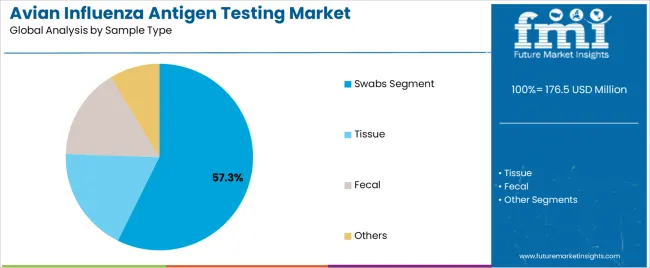
Swabs applications dominate the avian influenza antigen testing market with approximately 57.3% market share in 2025, reflecting the critical role of respiratory sample collection in supporting specialized testing requirements and outbreak detection worldwide. The swabs segment's market leadership is reinforced by increasing surveillance trends, practical collection advantages, and rising needs for specialized diagnostic capabilities in poultry applications across developed and emerging markets.
The tissue segment represents the second-largest sample type category, capturing 23.2% market share through specialized requirements for post-mortem examination, pathological investigation, and direct viral isolation applications. This segment benefits from growing laboratory integration demand that requires specific collection protocols, preservation standards, and diagnostic validation procedures in veterinary markets.
The fecal segment accounts for 15.1% market share, serving environmental monitoring, flock-level screening, and specialized epidemiological surveillance applications across various agricultural sectors.
Key market dynamics supporting sample type growth include:
The avian influenza antigen testing market is driven by three concrete demand factors tied to agricultural disease management. First, outbreak prevention and biosecurity enhancement create increasing demand for specialized testing systems, with surveillance program expansion of 25-35% annually in major poultry producing regions worldwide, requiring comprehensive diagnostic infrastructure. Second, government initiatives promoting animal health monitoring and disease surveillance drive increased adoption of advanced testing technologies, with many countries implementing mandatory testing programs and regulatory frameworks for avian influenza management by 2030. Third, technological advancements in rapid detection methods and field-deployable solutions enable more efficient and scalable diagnostic approaches that improve testing quality while reducing response time and operational complexity.
Market restraints include complex regulatory requirements and validation costs for diagnostic platforms that can challenge market participants in developing compliant testing capabilities, particularly in regions where approval pathways for veterinary diagnostics remain evolving and uncertain. Technical complexity of sample collection and processing protocols pose another significant challenge, as antigen testing demands sophisticated handling procedures and quality controls, potentially affecting testing costs and operational efficiency. Accuracy limitations for field-based testing across different viral strains and outbreak scenarios create additional operational challenges for test providers, demanding ongoing investment in product development and validation programs.
Key trends indicate accelerated adoption in Asia-Pacific markets, particularly India and China, where poultry production expansion and regulatory infrastructure development drive comprehensive diagnostic testing adoption. Technology integration trends toward point-of-care testing platforms with real-time results, advanced multiplex capabilities, and integrated data management solutions enable scalable diagnostic approaches that optimize efficiency and minimize outbreak response delays. The avian influenza antigen testing market thesis could face disruption if significant advances in molecular diagnostics or major changes in disease surveillance methodologies reduce reliance on traditional antigen testing approaches.
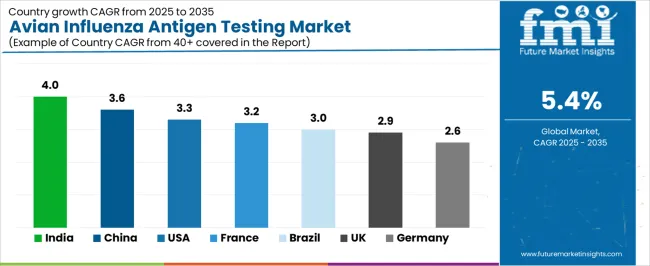
| Country | CAGR (%) |
|---|---|
| India | 4.0% |
| China | 3.6% |
| USA | 3.3% |
| France | 3.2% |
| Brazil | 3.0% |
| UK | 2.9% |
| Germany | 2.6% |
India demonstrates the strongest growth potential in the avian influenza antigen testing market with a CAGR of 4.0% through 2035. The country's leadership position stems from poultry production expansion, government-backed surveillance initiatives, and comprehensive disease control regulations driving the adoption of advanced diagnostic testing solutions. Growth is concentrated in major agricultural and poultry regions, including Punjab, Andhra Pradesh, Tamil Nadu, and Maharashtra, where commercial farms and integrated production facilities are implementing advanced testing protocols for enhanced disease management and outbreak prevention. Distribution channels through veterinary services and agricultural cooperatives expand deployment across production facilities and surveillance programs. The country's Ministry of Agriculture provides policy support for diagnostic technology modernization, including comprehensive surveillance capability development.
Key market factors:
In major agricultural and production centers including Shandong, Henan, Hebei, and Guangdong, the adoption of comprehensive testing solutions is accelerating across commercial farms and production facilities, driven by regulatory scaling and government agricultural programs. The avian influenza antigen testing market demonstrates strong growth momentum with a CAGR of 3.6% through 2035, linked to comprehensive agricultural modernization and increasing focus on disease prevention solutions. Chinese companies are implementing advanced testing systems and diagnostic platforms to enhance biosecurity while meeting growing demand in expanding poultry and agricultural sectors. The country's food safety enhancement initiatives create demand for diagnostic services, while increasing emphasis on export quality drives adoption of advanced testing systems.
Key development areas:
USA market expansion is driven by diverse agricultural demand, including commercial production in major states and comprehensive surveillance across multiple regions. The country demonstrates strong growth potential with a CAGR of 3.3% through 2035, supported by federal disease monitoring programs and industry-level biosecurity initiatives. American companies face implementation challenges related to regulatory complexity and validation requirements, requiring strategic development approaches and support from specialized diagnostic partners. Growing export demands and food safety requirements create compelling business cases for testing adoption, particularly in commercial operations where rapid detection has a direct impact on production continuity and market access.
Market characteristics:
The Germany market leads in advanced diagnostic innovation based on integration with veterinary systems and precision testing technologies for enhanced accuracy. The country shows strong potential with a CAGR of 2.6% through 2035, driven by the modernization of existing surveillance infrastructure and the expansion of advanced diagnostic facilities in major agricultural areas, including Lower Saxony, North Rhine-Westphalia, Bavaria, and Baden-Württemberg. German companies are adopting intelligent testing systems for quality improvement and compliance enhancement, particularly in regions with advanced poultry requirements and applications demanding comprehensive diagnostic upgrades. Technology deployment channels through established veterinary networks and agricultural operators expand coverage across production facilities and research-focused applications.
Leading market segments:
In Brittany, Pays de la Loire, and other major regions, agricultural facilities are implementing comprehensive testing solutions to modernize existing surveillance infrastructure and improve diagnostic capabilities, with documented case studies showing a 60% improvement in outbreak response through advanced testing integration. The avian influenza antigen testing market shows strong growth potential with a CAGR of 3.2% through 2035, linked to the ongoing modernization of production facilities, agricultural networks, and emerging surveillance projects in major regions. French companies are adopting intelligent testing and monitoring platforms to enhance operational reliability while maintaining standards demanded by the poultry and agricultural industries. The country's established regulatory infrastructure creates demand for diagnostic development and modernization solutions that integrate with existing surveillance systems.
Market development factors:
Avian influenza antigen testing market in Brazil demonstrates growing implementation focused on export compliance and production optimization, with documented integration of advanced diagnostic systems, achieving 50% improvement in testing efficiency across commercial and agricultural facilities. The country maintains steady growth momentum with a CAGR of 3.0% through 2035, driven by production facilities' emphasis on quality excellence and export compliance methodologies that align with Brazilian agricultural standards applied to diagnostic operations. Major production areas, including Santa Catarina, Rio Grande do Sul, Paraná, and São Paulo, showcase growing deployment of testing platforms where diagnostic systems integrate with existing agricultural infrastructure and comprehensive quality management programs.
Key market characteristics:
UK's avian influenza antigen testing market demonstrates established and development-focused landscape, characterized by growing integration of testing systems with existing agricultural infrastructure across production facilities, veterinary networks, and monitoring initiatives. UK's emphasis on disease surveillance and export standards drives demand for advanced diagnostic solutions that support comprehensive outbreak prevention and quality monitoring requirements in agricultural operations. The avian influenza antigen testing market benefits from partnerships between international diagnostic providers and domestic agricultural leaders, creating service ecosystems that prioritize testing excellence and regulatory compliance programs. Agricultural centers in major regions showcase developing testing implementations where diagnostic systems achieve efficiency improvements through integrated surveillance programs.
The avian influenza antigen testing market in Europe is projected to grow from USD 40.7 million in 2025 to USD 53.4 million by 2035, registering a CAGR of 2.8% over the forecast period. Germany is expected to maintain its leadership position with a 24.7% market share in 2025, declining slightly to 24.3% by 2035, supported by its extensive agricultural infrastructure, advanced veterinary facilities, and comprehensive surveillance networks serving major European markets.
France follows with a 12.1% share in 2025, projected to reach 12.7% by 2035, driven by comprehensive disease control programs in major agricultural regions implementing advanced testing systems. Spain holds a 13.1% share in 2025, expected to maintain 13.0% by 2035 through the ongoing development of commercial production facilities and agricultural surveillance networks. Italy commands a 8.8% share, while BENELUX accounts for 8.4% in 2025. The Rest of Western Europe region is anticipated to gain momentum, expanding its collective share from 25.1% to 25.2% by 2035, attributed to increasing diagnostic adoption in Nordic countries and emerging agricultural facilities implementing testing programs.
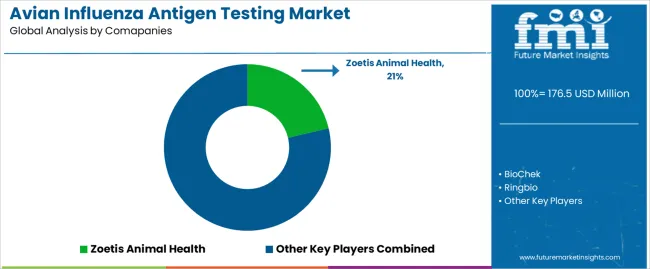
The avian influenza antigen testing market features approximately 15-25 meaningful players with moderate concentration, where the top three companies control roughly 30-40% of global market share through established diagnostic portfolios and extensive agricultural industry relationships. Competition centers on testing accuracy, operational reliability, and technical expertise rather than price competition alone.
Market leaders include Zoetis Animal Health, which maintains competitive advantages through comprehensive diagnostic service portfolios, advanced testing capabilities, and deep expertise in the poultry and veterinary sectors, creating high switching costs for customers. These companies leverage established agricultural relationships and ongoing development partnerships to defend market positions while expanding into adjacent veterinary and surveillance applications.
Challengers encompass BioChek and Ringbio, which compete through specialized testing technologies and strong regional presence in key agricultural markets. Diagnostic specialists, including Biopanda Reagents, Abbexa, and Elabscience, focus on specific testing technologies or vertical applications, offering differentiated capabilities in rapid detection, immunoassay systems, and application-specific solutions.
Regional players and emerging diagnostic companies create competitive pressure through innovative testing approaches and rapid deployment capabilities, particularly in high-growth markets including India and China, where local presence provides advantages in cost optimization and regulatory compliance. Market dynamics favor companies that combine advanced diagnostic technologies with comprehensive agricultural services that address the complete testing lifecycle from sample collection through ongoing quality assurance and technical support.
Avian influenza antigen testing solutions represent a critical agricultural service that enables poultry producers, commercial farms, and governmental agencies to enhance disease management and biosecurity without substantial in-house laboratory investment, typically providing 50-70% faster detection completion compared to laboratory alternatives while ensuring unprecedented accuracy and regulatory compliance. With the avian influenza antigen testing market projected to grow from USD 176.5 million in 2025 to USD 298.6 million by 2035 at a 5.4% CAGR, these solutions offer compelling advantages - superior speed, enhanced accuracy, and operational efficiency capabilities - making them essential for rapid antigen testing applications (42.3% market share), swab-based detection (57.3% share), and diverse agricultural applications seeking reliable diagnostic solutions. Scaling market penetration and testing capabilities requires coordinated action across agricultural policy, regulatory standards, diagnostic providers, farming companies, and veterinary institutions.
| Items | Values |
|---|---|
| Quantitative Units | USD 176.5 million |
| Test Modality | Rapid Antigen Test Kits, ELISA, Immunofluorescence, Others |
| Sample Type | Swabs, Tissue, Fecal, Others |
| End User | Veterinary Diagnostic Labs, Poultry Farms, Government/Surveillance Agencies, Research Institutes |
| Regions Covered | Asia Pacific, Europe, North America, Latin America, Middle East & Africa |
| Country Covered | India, China, USA, Germany, France, U.K., Brazil, and 40+ countries |
| Key Companies Profiled | Zoetis Animal Health, BioChek, Ringbio, Biopanda Reagents, Abbexa, Elabscience, CTK Biotech |
| Additional Attributes | Dollar sales by test modality and sample type categories, regional adoption trends across Asia Pacific, Europe, and North America, competitive landscape with diagnostic providers and veterinary companies, testing facility requirements and specifications, integration with poultry production initiatives and agricultural platforms, innovations in diagnostic technology and testing systems, and development of specialized applications with quality monitoring and detection optimization capabilities. |
The global avian influenza antigen testing market is estimated to be valued at USD 176.5 million in 2025.
The market size for the avian influenza antigen testing market is projected to reach USD 1,894.6 million by 2035.
The avian influenza antigen testing market is expected to grow at a 5.4% CAGR between 2025 and 2035.
The key product types in avian influenza antigen testing market are rapid antigen test kits , elisa, immunofluorescence and others.
In terms of sample type, swabs segment segment to command 57.3% share in the avian influenza antigen testing market in 2025.






Full Research Suite comprises of:
Market outlook & trends analysis
Interviews & case studies
Strategic recommendations
Vendor profiles & capabilities analysis
5-year forecasts
8 regions and 60+ country-level data splits
Market segment data splits
12 months of continuous data updates
DELIVERED AS:
PDF EXCEL ONLINE
Avian Flu Treatment Market Size and Share Forecast Outlook 2025 to 2035
Avian Metapneumovirus Treatment Market Analysis - Size, Share, and Forecast Outlook 2025 to 2035
Clinical Avian Nutrition Market Analysis - Size, Share, and Forecast Outlook 2025 to 2035
Influenza Antiviral Market
Influenza Home Testing Market
Seasonal Influenza Vaccines Therapeutics Market Size and Share Forecast Outlook 2025 to 2035
Paediatric influenza treatment market Size and Share Forecast Outlook 2025 to 2035
Testing, Inspection & Certification Market Growth – Trends & Forecast 2025 to 2035
5G Testing Market Size and Share Forecast Outlook 2025 to 2035
AB Testing Software Market Size and Share Forecast Outlook 2025 to 2035
5G Testing Equipment Market Analysis - Size, Growth, and Forecast 2025 to 2035
Eye Testing Equipment Market Size and Share Forecast Outlook 2025 to 2035
HSV Testing Market Size and Share Forecast Outlook 2025 to 2035
IoT Testing Equipment Market Size and Share Forecast Outlook 2025 to 2035
HPV Testing and Pap Test Market Size and Share Forecast Outlook 2025 to 2035
GMO Testing Services Market Insights – Food Safety & Regulatory Compliance 2024 to 2034
GMP Testing Services Market
LTE Testing Equipment Market Growth – Trends & Forecast 2019-2027
Drug Testing Systems Market Size and Share Forecast Outlook 2025 to 2035
Sand Testing Equipments Market Size and Share Forecast Outlook 2025 to 2035

Thank you!
You will receive an email from our Business Development Manager. Please be sure to check your SPAM/JUNK folder too.
Chat With
MaRIA